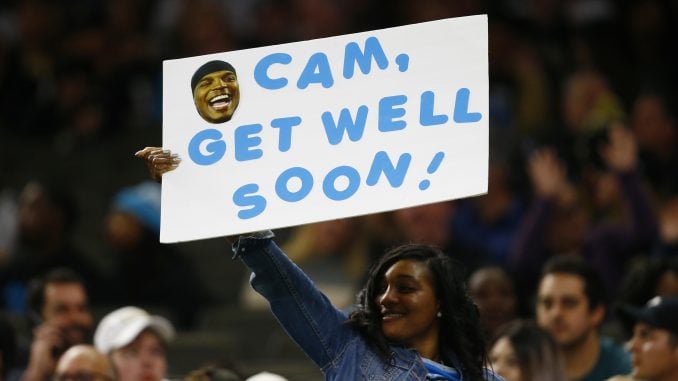
After battling a sore shoulder for much of last year, an injury that caused him to miss the final two games of the Panthers’ season, Cam Newton went under the scope last Thursday.
The Carolina quarterback had an arthroscopic procedure on his throwing shoulder, performed by Panthers team physician Dr. Pat Conner, and a release from the team said Newton would begin rehab “immediately.”
According to reports, the procedure didn’t involve a repair to any shoulder damage — it was merely “a cleanup,” likely of scar tissue remaining from his rotator cuff surgery following the 2017 season to repair a partial tear.
The NFL Network reported that Newton plans to throw at OTAs in April, a significant acceleration in the recovery timeline from the previous procedure, which had Newton limited into preseason training camp.
The most significant recent comparison for Newton is Colts quarterback Andrew Luck, who appeared to finally be back to full strength and production this season after a three-year battle with a shoulder problem.
Luck underwent surgery that kept him out the entire 2017 season. When he returned to the field this year, he topped 4,500 yards and 39 touchdown passes for the first time since 2014.
The Luck situation, and some cryptic comments by owner David Tepper during an offseason meeting with the media, led to social media reports that the team might be considering following a similar path with Newton, sitting him for the 2019 season to get him back to 100 percent.
Luck is far from the only other NFL passer to suffer shoulder woes. According to an NIH study by the University of Michigan’s Department of Orthopedic Surgery, the shoulder is the second most common overall injury in NFL quarterbacks. (Head injuries are No. 1.)
“The injury profile among professional quarterbacks is unique compared to other positions and other overhead professional throwing athletes,” the study’s authors wrote. “The quarterback position is disproportionately impacted by shoulder injuries when compared to professional athletes at other positions.”
The numbers from the study are surprising. Half of all athletes at the NFL Combine had a history of shoulder trouble, with more than a third needing shoulder surgery. Among quarterbacks, 71 percent of Combine attendees had a history of shoulder problems, and 15.2 percent of all injuries suffered by quarterbacks are to the shoulder.
Aaron Rodgers battled a shoulder injury in 2017, when he played in just seven games. Tom Brady had arthroscopic surgery on his shoulder in 2004 and was listed on every one of New England’s weekly injury reports with “right shoulder” for the next seven seasons.
Rotator cuff problems, like the one Newton had repaired in 2017, are far rarer among quarterbacks. That’s because the vast majority of shoulder injuries in the NFL are the result of violent hits. A quarterback doesn’t see the same type of shoulder problems as baseball pitchers — a sport where rotator cuff tears are far more common — because throwing football puts far less strain on the arm. The arm doesn’t reach anywhere near the same velocity, and the number of throws for a quarterback is far lower than a baseball hurler.
Among Combine attendees, the researchers found that, “Athletes with a history of rotator cuff tear were less likely to be drafted and played fewer games in the NFL.” However, the authors went on to caution, “This is difficult to extrapolate to the professional quarterback given the low overall prevalence (of the injury).”
Still, it happens to the best of them. Pittsburgh’s Ben Roethlisberger announced prior to the 2012 season that he was playing through a partial tear in his rotator cuff. The result was his lowest passing output in the last eight seasons.
He appeared to be back to his old self by 2013 and has gone on to post some of the best years of his career since.
So, the bottom line is that, while Newton’s shoulder problem is clearly serious, it appears to be a relatively minor setback this offseason — one that will hopefully be long since forgotten by training camp.
While the recurrence of a shoulder problem seems alarming, it also appears to come with the territory for an NFL quarterback. With scientific evidence, as well as some high-profile examples in the NFL, working in his favor, there’s no reason to think Newton will be limited by the injury going forward.




